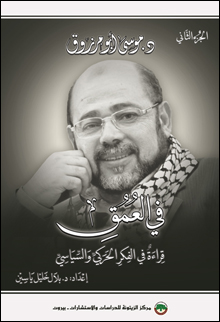Al-Zaytouna Centre has published a new Arabic book entitled, “Dr. Musa Abu Marzuq: In Depth: A Reading in Activism and Political Thought of the First Chief of Hamas Political Bureau,” which covers the 1997- 2017 period of Abu Marzuq’s life. It is the second part of a book entitled, “Musa Abu Marzuq: A Life Journey: Memoirs of Seeking Refuge, Emigration and the Years of Struggle” (the second edition of which was published by al-Zaytouna Centre in 2019).
The original text of this 524-page book was prepared by Dr. Belal Khalil Yasin, then it was reviewed and edited by Prof. D. Mohsen Mohammad Saleh and Iqbal Omeish. It covers the 1997- 2017 period of Abu Marzuq’s life, who was the first head of Hamas Political Bureau and one of its prominent founders and leaders.
| Click here to download:
>> Dr. Musa Abu Marzuq: In Depth: A Reading in Activism and Political Thought of the First Chief of Hamas Political Bureau 1997- 2017 (Arabic) |
This book is a basic reference for those who want to know more about the experience of Dr. Abu Marzuq, whether concerning the vision and political positions, or the national Palestinian struggle with its Palestinian, Arab, Muslim and international ramifications during the 1997- 2017 period. The importance of this book lies in the fact that it covers an important part of the history of the Palestinian Islamic movement and the Hamas movement, hence, it is an indispensable source for those writing about the contemporary history of Palestine. It contains important details about the internal Palestinian situation, the conflict with Israel, and the Arab, Muslim and international relations and positions.
It includes four chapters in addition to appendices containing photos and documents. The author chronologically displays the political and intellectual biography of Dr. Abu Marzuq during the 1997- 2017 period, showing his opinions at every stage, most of which overlapped with the positions of Hamas. At times, he had distinguished opinions, such as the call for the need to renew the Hamas charter in the early 1990s, and his support for Hamas’ participation in the 1996 legislative elections, in addition to other positions that are detailed in the book.
The introduction was written by the Speaker of the Palestine Legislative Council, Dr. ‘Aziz Dweik, who said that this book contains the most important features of Abu Marzuq’s strategic understanding. In his preface, this book editor and the General-Manager of al-Zaytouna Centre Prof. D. Mohsen Mohammad Saleh, considered these memoirs a qualitative addition to the experience of Hamas, and to the modern and contemporary history of Palestine. Another preface was written by the former head of the Arab Nationalist Forum Ma‘an Bashour, who saw that these memoirs display a vision and evaluate an experience, thus making them more of a draft program, not only for his movement, but for the entire Palestinian struggle movement.
The chapters of this book dealt with the most important phases and milestones that the Palestine issue went through, in addition to Abu Marzuq’s childhood, upbringing, and deportation or transfer between countries. The book also discusses the Palestinian factional relations, especially with the Fatah movement, and the management of the Palestinian national project, in addition to Abu Marzuq’s most important practical initiatives, his relations with Hamas during nearly twenty years, forming the Alliance of the Ten Factions, and his deportation to Marj al-Zuhur.
This book discusses the conflict with Israel and its tools, the Oslo Accords, and the minimum that Hamas could accept in the settlement. It details the normative standards governing the relationship of with local, regional and international parties. It reviews the reasons of the abstention of Hamas from participating in the 1996 legislative elections, its participation in the 2006 elections, its formation of the government, the developments of the Palestinian schism, the reconciliation efforts and the most important agreements concluded in this regard; The 2005 Cairo Agreement, The National Conciliation Document of the Prisoners 2006, the 2009 draft agreement, the Cairo Reconciliation Agreement 2011 and the obstacles that prevented its completion. The book also discusses the 2008 aggression, the secrets of the indirect negotiations during the 2014 aggression, and the Great Return Marches that began in 2018.
The book mentions the revolutions and the changes that took place in the Arab world after 2011, and presents Abu Marzuq’s analytical reading of the Arab Spring. In addition, it discusses Hamas’s new political document launched in 2017.
The author discusses the relationship of Abu Marzuq with Yasir ‘Arafat (Abu ‘Ammar) and Sheikh Ahmad Yasin, in addition to the opinion of Abu Marzuq of many prominent Palestinian, Arab and Muslim personalities that he knew or met, such as: Khalid Mish‘al, the Yemeni President ‘Ali ‘Abdullah Saleh, the Iraqi President Saddam Hussein, the Syrian Presidents Hafez and Bashar al-Assad, the Libyan President Mu‘ammar Gaddafi, the Egyptian President Muhammad Anwar Sadat, the Jordanian King Hussein, Major General ‘Umar Suleiman, he Secretary General of Hizbullah, Hasan Nasrallah, and the General Guide of the Muslim Brothers movement, Muhammad Badi‘. Many figures made testimonies concerning Abu Marzuq as a person, including his wife Nadia al-‘Ashi, Dr. Yasir Bushnaq, Dr. Ahmad Yusuf, who suggested the idea of this book, Dr. Mustafa al-Lidawi, Isma‘il al-Bar‘asi, Husni al-‘Attar and Nidal Khadra.
At the end of the book, one can find appendices containing photos of that period, important documents and an index of important figures, places and institutions.







 ||
||

Leave A Comment